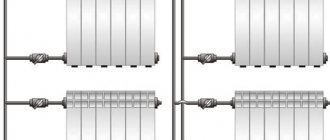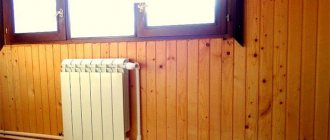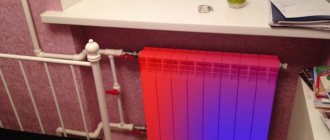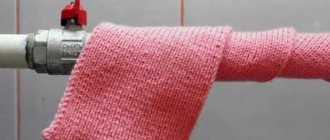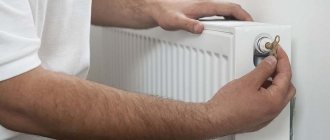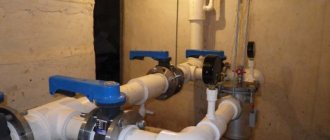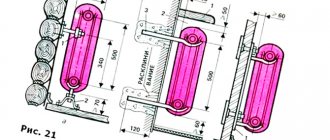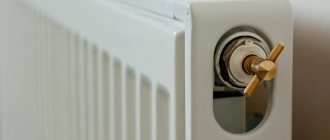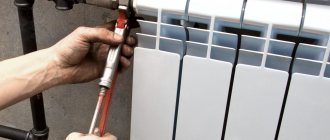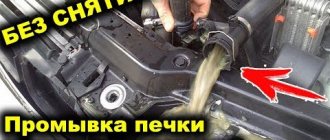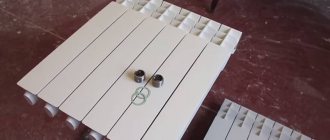What are the reasons for uneven heating of radiators
Batteries are an integral element of a home heating system. It is their serviceability that determines how warm the rooms will be. With proper connection and proper operation, radiators can effectively heat the air in large rooms and maintain a comfortable temperature for a long period. However, what should you do if the top of the radiator heats up well, but the bottom remains cold? First of all, you need to figure out why this happens.
The bottom of the batteries gets hotter
Let us immediately note that most battery models are designed in such a way that during operation their lower part heats up a little worse. This is explained by the high degree of heat transfer - during its stay in the radiator, the water has time to cool slightly before it begins to flow out of the batteries. As a result of this principle, the upper part of the device will always be hotter. Therefore, there is no need to worry if, during operation of the heating elements, their surface does not heat up completely evenly.
It's worse if you touch the device and notice a large temperature difference. This directly indicates that the radiator was not connected correctly, or the liquid in it is circulating at an insufficient speed. In the first case, the master most likely mixed up the pipes for the outflow and supply of water. Many property owners face this situation. The reason is the lack of qualifications of the called technician or an attempt to connect the radiator with your own hands. In the second case, the bottom of the radiator is cold due to the low flow rate of water inside it. This allows the liquid to cool completely before flowing out of the element.
Cold
The radiator may have a cold bottom if it is installed in a room with low temperatures. Or if it is installed on a loggia or veranda. In cold weather, the liquid in the batteries cools much faster.
Incorrect connection and methods to solve the problem
By incorrectly connecting radiators, apartment owners risk being left without effective heating in their residential premises. Such a gross mistake, in most cases, is made by self-taught people. Having mixed up, they connect the pipe for the outflow of water upward, and the channel for supplying liquid to the lower pipe. As a result, a lot of problems arise:
- water circulation changes completely;
- the efficiency of the radiator is significantly reduced;
- the process of water outflow changes;
- the risk of corrosion in the upper part of the radiator increases.
In an incorrectly connected element, liquid enters through the lower pipe, flows in a circle and comes out. Thus, not all sections of the radiator are heated, which is why its efficiency decreases significantly. The connection at the top does not make it possible to drain water from inside the device, because there is no such high pressure inside the radiator. When water gets inside, it tries to immediately rise to the top of the element. This is due to the fact that hot water has a slightly higher density than cold water. Because of this, the coolant travels the shortest path, skipping sections of the radiator.
If connected correctly, liquid enters from the top of the device and flows along the upper manifold. Due to the low pressure in the radiator, the coolant enters the columns and flows into the lower part. In this case, the element works effectively. To solve the problem with incorrect connections, first of all, disconnect all pipes from the radiator. Reconnect the pipes so that water flows in through the top pipe and outflow through the bottom hole. After that, check the result of the work.
Solving key difficulties with a radiator and how to deal with problems
If you start to wonder: “Why is the heating radiator in the room at the top hot and cold at the bottom?”, then it’s time to take the necessary measures without delay.
Properly connected battery
To determine the cause, follow the following algorithm:
- it is necessary to check the accuracy of the pipe connections;
- look at the radiator itself;
- release the air and clean the device;
- it is necessary to check the condition of the valves for adjustment;
- look through the pipes;
- the pump needs to be checked.
Cold batteries, possible reasons why the radiator does not heat
The initial stage requires checking the correctness of the connection. First, estimate the temperature of the pipe section at the bottom of the radiator. If the device was connected incorrectly, the lower section of the pipe will be hot. To solve the problem, you need to turn off all the pipes and reconnect them according to the above principle. If you do everything correctly, the lower section of the pipe will be barely warm.
Very often, an air plug will appear in the radiator, which interferes with the normal heating process of the element. In order to solve the problem, the device must have an air vent or a separate seal for releasing air. To purge, you need to close the air supply, fully open the drain and release all the air. Afterwards, the tap must be returned to its previous position and the system valves must be turned. In most cases, this procedure gives the desired result.
If the system is equipped with an adjustment valve, then the problem may lie there. Remove the faucet and inspect it carefully. If you see a narrowing of its end, you will need to return the part to its original diameter using pliers. Most experts advise replacing the faucet immediately in order to increase the effective operation of the system.
If there is no tap, then most likely the problem is hidden in the pipes. We recommend removing the channels with a specialized removable wrench and cleaning them from corrosive damage and other contaminants. If the pipes are no longer suitable for use, replace them with new ones.
Often there is no high pressure in the system due to its design properties. You should find out about this when you buy a living space or a private house. To increase this indicator, change the outdated pump or purchase one if there is no pump as such. This will increase the speed of movement of the coolant and ensure more efficient operation of the entire system.
Thematic publications:
The heating radiator does not warm up completely!
Heating scheme of a one-story house with forced circulation
Why does the pressure in the heating system decrease?
The heating radiator is hot on top and cold on the bottom.
The battery is clogged
The formation of a blockage in a heating device is one of the most common causes when the bottom of the radiator is cold and the top is hot. The reason is the insufficient quality of the thermal fluid. The water supplied to the heating system often contains impurities, which, under the influence of high temperature, form into plaque that accumulates on the inner surface of the radiators.
The result of the blockage is a disruption in the movement of the heated coolant through the radiator and its uneven heating. To eliminate circulation problems, you can use mechanical and chemical methods to clean the radiator. In the most difficult cases, specialists often use hydrodynamic and hydropneumatic methods, as well as highly effective electro-hydropulse cleaning of batteries.
The shut-off valve is broken
Shut-off type fittings are intended to completely or partially shut off the supply of coolant to the heating network. The main components of such fittings are presented:
- valves;
- ball valves;
- thermal heads with mechanical or automatic adjustment.
The lower part of the battery does not warm up, but the upper part becomes hot due to malfunctions inside the faucet. As a rule, problems are caused by a broken valve or any other disturbance that prevents the correct functioning of the element, as well as the unimpeded circulation of heated liquid.
Self-installation of fittings in the form of a valve requires increased attention. The manufacturer must indicate the direction of movement of the coolant directly on the housing. It is in accordance with this marking that this element should be installed. Any violation of installation rules is the main reason for the lack of trouble-free movement of water.
The role of return and its difference from supply
Sometimes, when carrying out plumbing work on their own, the user does not know how to identify the supply and return pipes when the battery is connected. If you are completely unfamiliar with the design, you can use a thermometer, identifying the supply and return pipelines by the temperature difference, if you know the circuits for discharging coolant to the heating radiators, consider the following options:
- With diagonal and side switching, the supply is always at the top and the outlet at the bottom.
- In the lower connection, the direction of movement of the input and output flows is sometimes indicated by arrows on the supply unit (binoculars).
- In Leningradka, the return pipe is considered to be the one coming from the last radiator in the row.
- In the manifold distribution, the supply combs are equipped with adjustable supply sensors in the form of fittings with transparent caps and indicators placed inside; the shut-off valves of the return comb are closed with threaded plugs. Also, the color marking of the forward feed is red, and the return feed is blue.
Rice. 3 Organization of heating systems using an open expansion tank
The return line plays no less important role than the direct line for supplying media to heat exchange devices or heated floors, its purpose and installation methods:
In gravity flow structures with an open storage tank. The movement of water in open circuits occurs due to the difference in hydrostatic pressures of the cooled and hot water columns due to the fact that the hot liquid has a lower density.
Therefore, the return line is designed and installed taking into account the following rules:
- Heat loss in the return must be quite significant to minimize the cooling of the water, that is, the batteries must have significant heat transfer.
- As the distance from the bottom point of the radiators to the boiler inlet pipes increases, the length of the low-temperature column increases and, accordingly, it more effectively displaces the heated coolant. The high location of the boiler from the battery lengthens the section with a cooled return, while simultaneously shortening the section of the high-temperature column - as a result, a large temperature difference shifts the working fluid much further up the circuit and heating occurs more efficiently.
- The upper installation of the boiler is contradicted by the condition under which it must be at a height below the level of the last batteries in the chain for the gravity flow of the carrier into it at an angle. If the boiler is installed low in the basement, to ensure normal circulation during installation, slopes towards the heating unit should be observed (2 - 3 mm per linear meter).
It should be noted that both of the above schemes are working (the latter is used more often) and their choice is related to the convenience of installing boiler equipment in the house.
Rice. 4 Closed heating system - diagram
In closed circuits with an electric pump. In multi-circuit heating with heated floors, circular pumps are installed that create the required pressure in the main; in many cases, two circular pumps are used - one pumps water throughout the system, and the second supplies coolant to the floors or radiator heaters.
With collector wiring, the return temperature relative to the supply plays an important role; the difference should not exceed 10º C, standard differences are 55 - 45, 50 - 40, 45 - 35, 40 - 30 degrees. To achieve these parameters, the cooled coolant from the return manifold is partially mixed with the hot coolant coming from the boiler, and then supplied to the heated floors.
In boiler piping. When the boilers are put into operation, the initial difference between the supply and return temperatures is quite significant - this leads to the formation of condensation on the walls of the heating chamber and chimney pipes, which, entering into a chemical reaction with carbon dioxide and other combustion products, causes accelerated corrosion of their surface.
To prevent these negative consequences, a small circuit is created with an adjustable check valve, in which the temperatures of the coolant entering the boiler and the heated fluid are quickly equalized. After reaching the specified temperature threshold, the thermal valve automatically opens and the entire system line is connected to the small heating circuit.
Sometimes, to equalize the temperature parameters of the supply and return, a bypass jumper of small diameter is installed between them; the width of its passage channel can be adjusted with screw valves (ball valves are used only for completely closing and opening passages).
There is air in the radiator
An air-filled heating system is also ineffective in heating rooms. As a rule, such an unpleasant situation with the accumulation of air bubbles in radiators is observed in apartment buildings on the upper floors, which is easily explained by the elementary laws of physics - air rises towards the roof. Usually such batteries have a cold top, but this does not exclude the fact that there may also be a cold bottom.
For preventive purposes, standard Mayevsky taps are installed, through which all the air accumulated in the radiators is drained from the system. You need to shut off the hot water supply pipe and leave the “return” in the open position, then open the tap and let out the air. After closing the tap, the supply of coolant to the radiator is resumed.
Basic malfunctions of heating systems and their elimination
Air jams
Air pockets occur in radiators and pipes and interfere with the normal circulation of water in the heating system. They appear for various reasons:
- violation of the technology for filling the system with water after the summer period;
- non-compliance with water deaeration regime;
- performing repairs with disassembling pipelines;
- failure to observe slopes when installing the heating system;
- air leakage through leaky joints.
To remove air from the system, use a Mayevsky valve installed on the radiator. You should open it, wait until the air comes out, the hissing stops, and the water begins to pour out calmly without bubbles. After this, the valve is closed. Don't forget to provide a container or towel to drain the water.
Old cast iron batteries do not have Mayevsky taps. The air is released without completely unscrewing the plugs at the ends of the radiators. It is better to entrust this operation to plumbers - if you unscrew the plug completely, you can flood the apartment.
In the cold season, the main thing is good heating. Unfortunately, not all houses in winter remain at a comfortable level.
This applies to both multi-apartment housing and the private sector. Why is this situation happening and what to do?
Low temperature
If the difference in the temperature conditions of the bottom and top of the batteries is not too significant, then there is no need to worry. This arrangement of radiators is quite natural. The circulating coolant always has time to cool down a little, which is due to fairly high heat output rates. Very large discrepancies may require system intervention.
If the water temperature in the heating system is low, then it will be necessary to increase the heating of the coolant by increasing the power of the operating heater. A good result is also achieved by using a special heat-reflecting screen. For this purpose, it is recommended to use traditional aluminum foil or modern and reliable material such as penofol.
An important point with a two-pipe connection is the ability to regulate the temperature in a separate battery using special fittings, represented by a conventional shut-off valve. This ensures an increase or decrease in the volume of coolant in each radiator by adjusting the shut-off valves.
Incorrect installation of the radiator
If the heating system is not connected professionally, the top of the radiator will heat up, but the bottom will remain cold. Installing a bypass and correct installation of shut-off valves requires special attention.
Note!
Chipboard: what is it? Types, application features, photos, sizes, thickness, explanation, manufacturers
DIY houses made from shipping containers step by step: instructions, diagrams, pros and cons, photos, design
Working pressure in the heating system in a private house: what it should be, how to create it, instructions for adjusting it yourself
Low coolant speed
Insufficient coolant velocity directly depends on the design of the heating system, the characteristics of the coolant, the power and performance of circulation pumping equipment, pipe material and diameter.
Optimal indicators:
- private households and apartments - 0.5-1.5 m/sec;
- production premises - within 3 m/sec.;
- administrative buildings - within 2 m/sec.
The speed of movement of the coolant in pipeline heating systems is taken in accordance with the permissible equivalent sound level in rooms for various purposes. When the power of the pumping equipment is reduced, the movement of the coolant slows down, which has time to cool down and the last radiators warm up worse. As a special case, the bottom can be cold and the top of the radiators hot. In this case, it is necessary to increase the power indicators of the device, which will ensure not only faster circulation, but also the most uniform heating of the radiators.
Don't miss: Vertical two-pipe water heating systems
Why does the heating system work poorly in a private house?
There are several reasons why the heating system in a private home does not work well and the room does not warm up enough.
Electric boiler does not heat well
This usually happens due to insufficient boiler power. Its approximate calculation is made based on the norm of one kilowatt for every 10 square meters of area. The resulting value is increased by a quarter if the boiler is used to heat hot water and by another ten percent as a power reserve. There are correction factors that allow you to adjust the final figure in accordance with the climate zone. For the south it is 0.7-0.9, for the middle zone 1-1.5, for the north up to 2.
Photo 3. An example of calculating the power of an electric boiler for private houses and apartments of various types.
Problems in radiators in which coolant circulates
The next two problems are radiators and impaired coolant circulation. In the private sector, purified water is not always used for heating, so the likelihood of blockages and corrosion is higher. Although the pressure allows the installation of aluminum and steel radiators, they must be protected from debris by filters and from wear by an anti-corrosion coating on the inside.
The second reason for poor water flow is an error in setting up the system. To make the adjustment, the pressure is calculated based on the volume of the system, pipes of the appropriate diameter are selected, and the boiler is adjusted.
What are the consequences of inefficient operation of heating devices?
A certain part of homeowners believe that if bimetallic radiators are hot at the top and cold at the bottom, then there is no need to worry too much - it will somehow get better. In reality, this problem causes a lot of inconvenience, which may ultimately result in serious repairs:
- The efficiency of heating appliances decreases.
- Reducing the room temperature.
- Adjusting additional reinforcement does not correct the situation.
Important! Do not forget that a small temperature difference between the top and bottom of the batteries is not a significant indicator of malfunction. Another thing is a significant difference in heating; it negatively affects the heating efficiency.
Room too cold
The battery can be hot at the top and cold at the bottom if it is located on a veranda, an uninsulated loggia, or in a corner room. This is a common problem in climates with harsh winters.
In these cases, the metal surface and working fluid cool down very quickly. According to the laws of physics, warm layers tend to rise. This causes a temperature difference. For the same reason, it is always colder near the floor than near the ceiling.
To correct the situation, it is necessary to increase the temperature of the coolant. This can be done using a climate control system, but not all homes have it. Then using a reflective screen will help. To do this, use aluminum foil or penofol.
The temperature in the apartment should not be lower than plus 18-20 degrees. If it does not reach these indicators, write a complaint to the service company. Submit your application in writing. Make two copies. Leave one (indicating the incoming number) with you, and the second - at the reception.
The master will come at the appointed time. He will take measurements, correct problems and recalculate the tariff.
New bimetallic radiators have a cold bottom while the top is hot: possible reasons
As already noted, for all models the heating of the lower region is weaker than that of the upper. This is explained by the high heat transfer of the bimetal - the water has time to cool thoroughly during the passage. Hence the temperature difference, which worries owners so much.
When not to worry
But with such insignificant differences there should be no reason for concern - this is a normal situation, given the features of this type of device:
- A single vertical channel in each section (for example, cast iron products have two).
- Small channel diameter (little coolant), but effective heat transfer due to the special configuration of the fins.
- Profiled convection channels between the ribs of the sections contribute to enhanced heat transfer, regardless of whether the battery is made by Italian or Russian.
- The thin walls of the sections heat up quickly, but also cool down just as quickly. Therefore, if you have bimetallic radiators at home and the bottom is cold and the top is hot near the appliances, this property needs to be taken into account.
Probable causes of uneven heat transfer
Despite similar trends, each case must be considered individually. If we ignore three important factors: incorrect calculation of the power of the boiler, pump and number of batteries, then we should take into account the likelihood of the following problems:
- Air jams are an inevitable consequence of measures to fill the structure with coolant. An additional symptom is gurgling or hissing sounds. The solution is the installation of a Mayevsky crane.
- Clogging of heating appliances is the result of neglecting regular flushing of the system, especially in apartments with a central heating system.
- Unsatisfactory coolant circulation - if distant heating units do not heat up well, then it is worth considering this reason, in particular in systems with natural circulation. To solve the problem when bimetallic radiators are hot at the top and too cold at the bottom, installing a circulation pump will help.
- Incorrect operation of the heating structure is a fairly common factor when the bypass is not adjusted. Even experienced home craftsmen who know how to properly install a battery with their own hands make mistakes when performing commissioning work.
- Problems with shut-off valves - proper installation of these units does not guarantee that over time the mechanism or electronic components will not fail.
Questions about housing and communal services The battery in the apartment is cold, what should I do?
To your question “...What should I do? Where to contact? The housing office is not doing anything” - look at the answer to Maria’s question “How to deal with public utilities?” a few days ago. In the Nizhny Novgorod region, it is believed that the most effective way to fight with housing and communal services for your rights is to contact the main “plumber” - the governor of the region. So in one of the articles in the press they write: the increase in the number of complaints from citizens to the governor about the inaction of housing and communal services is evidence of the growth of trust and authority of the governor! True, I personally would like the growth of the governor’s authority to be the result not of an increase, but of a sharp decrease in complaints about housing and communal services. If plumbers do come to you, do not rush to immediately change the battery on their advice! This is their favorite trick - to rip off money for the battery. Demand that they first disassemble and repair the valves or clean the pipes on the supply to the battery. Good luck to you, Irina, and a hot battery! Yuri
You can answer briefly: the reason is the low water flow through the battery. You can answer in more detail, but it will be very long. There can be many reasons:
1. The inlet or outlet pipes of the batteries are clogged with deposits (rust, salts), or the batteries themselves are clogged.2. The valves in the basement through which the direct or return riser are connected to the main pipelines of direct or return water are faulty (or closed). Low consumption of coolant (hot water) throughout the house, or only through the risers of your entrance.4. Insufficient performance (power) of pumps in the boiler room, from which water is supplied to the heating system.5. Poor adjustment (adjustment) of the heating system of the neighborhood or your home.
In any case, contact the house management company. If the plumbers tell you, “We don’t know the reason,” tell them everything you think about these slackers and ignoramuses. If the plumbers do not fix the problem, write a letter of complaint to the house management company, the State Housing Inspectorate, the city administration, or the regional governor.
If there is a craftsman in the family or among neighbors whose “head and hands grow out of place,” show him the following text and ask him to try to determine the cause of cold batteries:
To determine why the flow rate is low, check:
- Are the batteries on other risers in your apartment heated well? - Are the batteries on the same riser in the apartments above or below you heated well? - Are the batteries in the neighboring entrances heated well?
If the batteries on other risers in your apartment, as well as in the apartments above or below, heat up normally, it is most likely that the valves at the inlet or outlet of a poorly heating battery are faulty, or the inlet or outlet pipes of this battery are clogged, or the battery itself is clogged.
If the radiators on the same riser in the apartments above or below you also warm up poorly, but on the neighboring risers it is good - this is most likely faulty (or covered) valves in the basement through which the direct or return riser is connected to the main pipelines of direct or return water . Or maybe the direct or return riser pipes are clogged.
If the radiators on all the risers in your apartment do not warm up completely, this is most likely due to the low flow of coolant (hot water) throughout the house, or only in the risers of your entrance. To make sure of this, go to your friends in another entrance - how do their batteries heat up?
If the entire neighborhood freezes, it’s the boiler house’s fault (CHP)
You can also write to the website, providing as much detail as possible - where and what in your apartment and in neighboring apartments and entrances it heats or does not heat. And what are the specific temperatures at the inlet and outlet of the battery and the air temperature in the apartment. If we can help with anything else, we don’t mind the advice.
Good luck in identifying the reasons why batteries do not heat well!
What to do if the batteries are clogged
A clogged heating radiator is a common problem when operating batteries, which leads to various troubles. Dirt accumulates inside the devices due to poor quality coolant and the presence of air. This is especially true at the beginning of the heating season. When heating starts and stops, look here.
In self-contained circuits that do not rely on central heating, dirt and debris can enter through an open hydraulic tank. Particles and batteries settle at the bottom and in the nooks and crannies of the battery, resulting in disruption of coolant circulation. The batteries begin to heat up worse. A severe blockage leads to the fact that the radiators become completely or half cold.
Clogging also occurs due to the accumulation of excess air and the formation of an air lock. Modern bimetallic batteries are easy to maintain. In this case, you can remove excess air by opening a special tap. If the problem is an air lock, a hiss will follow from the hole. If the problem is different, coolant will flow from the tap. In this case, immediately close the tap.
For old cast iron batteries such a faucet is not provided. If there is an air lock, you will have to look for the coupling, which is located at the connection of the pipe with the approach to the radiator. Turn the coupling and dirty coolant will flow out of the tap. Drain a little and twist back. To avoid staining the floor, place a container under the coupling first. Do not unscrew the coupling completely, otherwise there is a risk of flooding!
Why is the battery not all hot?
The efficiency factor (efficiency) depends on the uniform heating of the heating battery. If this indicator does not reach the optimal level, then there is no need to talk about a comfortable temperature in the room.
A hot top and cold bottom of the radiator occurs not only in old cast iron systems, but also in innovative bimetallic systems.
Airy battery
The problem is most typical for multi-storey buildings and upper floors. This is due to the laws of ordinary physics - air flows are always directed upward.
The concept of airiness means the presence of accumulated air inside the heating system, which is why water flows cannot fully move through the pipes and radiator.
If the apartment has old-type batteries installed - without a Mayevsky tap, you will have to call a mechanic from the housing office to remove the air. But first, try to bleed the air from the battery yourself:
- Find the coupling that is located at the junction of the pipe and the approach to the battery.
- Unroll it, after which the water will flow out, and the air will go with it.
Don't forget to place a basin to drain the liquid. Otherwise, water will flood the floor and flood the neighbors below.
If this is a private house, then the problem can be solved simply:
- Shut off the general heating supply.
- Open the bleeder located at the top of the system.
- Remove air using back pressure.
It is much easier to eliminate stagnant air masses in modern radiators that are equipped with special taps. How to do it right:
- Turn off the tap on the pipe supplying hot water to the battery. Leave the return valve open.
- Open the bleeder valve and wait a few minutes, which will allow all the air to leave the system.
- Close it and turn on the water.
If such actions do not change the situation, then the problem lies in another cause.
Radiator. How to remove air? Top Hot, Bottom Cold...What to do? (2021)
Simple clogged radiators
The second most common cause of cold bottom and hot top in radiators is the accumulation of contaminants inside the system. There are many reasons:
- Poor quality thermal fluid. This is a problem for any city and country. Low-grade untreated water containing various impurities is used for heating. In the normal state, they easily move through the coolant. When heating occurs, the particles form a larger fraction, which settles on the surface of the metal.
- Garbage from outside. This applies to heating systems that do not depend on central heating. Dirt penetrates into such autonomous circuits through open hydraulic tanks. As a result, all the debris, along with the flow of water, ends up in the heating radiators, which completely disrupts the circulation of coolants.
- Air accumulation. In this case, an accumulation of anaerobic bacteria occurs. They exist due to the presence of oxygen in the heating system. During their life, microorganisms release waste products. They settle on the inner surface of the radiator, and when they accumulate, they create a dense sediment that interferes with the circulation of water flow.
- Heat exchanger design. There are batteries in which water, when moving, changes the vector of its movement in a permanent way. As a result, dirt is deposited in hard-to-reach corners.
If the problem of the cold bottom is clogging, 2 methods of eliminating it are used - chemical and mechanical. What you can do yourself:
- Remove the battery. To do this, disconnect the device from the pipes using tools.
- Drain the radiator.
- Tap all sections with a rubber mallet or mallet. The action will allow the rust and plaque to separate from the surface.
- Shake the battery. Turn over so that debris comes out from inside to outside.
- Take a sealed hose, pour hot water into the battery through it, and add a special detergent. Leave for 30 minutes.
- Drain the boiling water, reinsert the hose connected from the back to the cold water tap. Turn on full pressure and rinse with flow. Such intensive actions remove all remaining debris.
When calling specialists, electrohydraulic pulse, hydropneumatics or hydrodynamics are used.
Malfunctions in shut-off valves
The shut-off valves are located in the heating circuit, acting as a water flow regulator and a shut-off element when moving the working fluid. Consists of a ball valve, an electronically/mechanically controlled thermal head and a plug valve.
If a malfunction occurs in the shut-off system, the circulation of the coolant is disrupted. To correct the situation, carefully inspect the fittings and replace the faulty part. If it is difficult to do this on your own, hire a specialist.
The bottom of the BATTERY is Cold and the Top is Hot (7 REASONS)
Insufficient pressure in the system
The problem most often occurs in modern type radiators. The reason is the structure of the structure. If in Soviet-era batteries the passages were impressive, then in the updated versions they are narrow, so an increased level of pressure is required for normal and stable movement of the working fluid.
The passages include such elements as the labyrinth of the heat exchanger, pipes (inlet and outlet).
If the line was originally intended for cast iron systems, then it will not be able to generate the necessary pressure for modern models with narrow passages.
There are other reasons:
- faults in the main line - repair is required;
- connection of a heated floor by neighbors - in this case, more pressure is required, and since the heating system is located in the lower part of the room, the bulk of the pressure is directed there;
- the presence of a valve on the bypass slows down the pressure;
- increasing the number of sections (including neighbors) - more pressure is required;
- neighbors regulate their radiators, which negatively affects the flow of coolant in nearby apartments.
Why does low pressure make the bottom of the radiator much colder than the top? The answer to the question has the following variations:
- the balance is disturbed;
- air jams form;
- the coolant cools quickly;
- incorrect cross-section in the pipeline;
- low power of pumping equipment;
- water leakage occurs (as happens with heated floors).
Methods for solving the problem:
- call the management company, since it is impossible to fix the problem yourself;
- if breakdowns are not detected, then the culprits are the neighbors who made adjustments to the heating system without informing the heat supplier.
Such actions are considered illegal. When heating conditions for apartments change, the supplier must adjust the pressure level to ensure even distribution of the coolant.
Incorrect installation and connection of radiators
When connecting heating radiators, specialists adhere to a certain scheme. If this is not done, then not only does the bottom become cold, but other problems also arise (the risk of pipeline rupture increases).
Most often, the valve is installed incorrectly on the bypass (this is a pipe connecting the return pipe and the internal supply element of the working fluid). When connecting heating, the bypass must be closed, and preferably installed closer to the battery.
The heating radiator malfunctions for other reasons:
- incorrectly selected pipe diameter;
- incompatibility of battery and boiler.
To solve the problem, check the installation according to the connection diagram. In this case, it is better to contact specialists.
The coolant is moving at insufficient speed
The speed of the coolant is influenced by several factors. They are as follows:
- characteristics of water;
- diagram of the entire heating system (it does not have pumping equipment, but works by gravity, etc.);
- performance and power of the pumping unit;
- pipe diameter is narrow;
- equipment clogging;
- material used in the manufacture of batteries and pipes.
The coolant movement speed for private houses and apartments should vary from 0.5 to 1.5 m/sec.
The bottom of the radiator becomes much colder than the top because the water has time to cool due to its slow movement. Having reached the return line, the working fluid is already completely cold.
It is almost impossible to identify the cause on your own. You will have to contact the coolant supplier. If the cross-section of the pipes is narrow, you need to replace this part of the water supply; if the power is weak, increase it; if the material of the equipment does not hold heat, you need to buy a new one, etc.
If the battery does not warm up completely
Cold room
The bottom of the battery may be cold if the heating radiator is located in the veranda/corridor of a private house or on the loggia of an apartment. When the air temperature is cool, metal surfaces quickly cool, which is why the working fluid also cools.
Since the water is initially directed along the top of the battery, and then along the bottom, there is a corresponding temperature imbalance - the bottom is colder than the top. Another reason is that the cold is more concentrated in the floor area, and the heat is concentrated at the top, in the ceiling area.
How to clean clogged batteries
- To clean the radiator from debris and dirt, you will have to remove the device and wash it. Before starting the procedure, prepare the area for cleaning. It is better to clean radiators outside or in the bathroom;
- First cover the bathtub with a thick cloth and insert a protective mesh into the drain hole to avoid damage to the enamel surface of the plumbing fixtures and prevent clogging of the pipeline;
- Close the valves and unscrew the nuts, carefully drain the remaining water, remove the radiator and place it outside or in the bathroom;
- Tap each section with a hammer or mallet to help the rust and plaque fall off quickly. Then carefully shake out any accumulated debris from inside;
- For washing, use a special sealed hose to clean the battery under high pressure. Simply rinsing the device under the tap or in a basin will not clean it. Special cleaning agents can also be used along with water. To be effective, pour hot water into the radiator and leave for half an hour, and then rinse;
- If the radiator is severely clogged, most likely the other radiators are also clogged. In this case, you will have to wash each battery. Many bimetallic radiators are washed extremely rarely, so a large amount of solid particles and debris accumulates inside. In addition, plaque and rust may appear;
- When cleaning yourself, be careful, as you can easily get burned due to the hot coolant. It is better to entrust the work to specialists. If you want to do the procedure yourself, you will find useful tips and tricks in the article “How to clean a radiator.”
Heating system clogged
The last battery is too long.
Why is one battery hot and the other cold? Experts cite the following reasons for this situation:
- airing of the system;
- low quality coolant;
- poor quality heating element.
Airing the system. Air may accumulate in individual elements of the heating system. This phenomenon is called circuit airing.
Air can get into the wiring:
- from an open expansion tank;
- if ordinary tap water was used as a coolant. It contains a certain percentage of dissolved air;
- the aggressive coolant environment oxidizes the walls of aluminum radiators. As a result, oxygen is released. It accumulates inside, forming a plug.
It is easy to determine whether there is an air lock inside the heating equipment. To do this, you need to simultaneously turn off the taps on the supply and return pipes, and then open them in complete silence. If there is extraneous noise and gurgling inside the device when the tap is opened, there is an air lock there. This is the main reason why one battery is cold and the rest are hot.
Batteries are often cold due to deposits on the inner walls of the case. The reason for their appearance is various impurities in the composition of the coolant and products of the interaction of hot water and metal. What to do in this case?
Cleaning radiators in an apartment is carried out in several ways, each of which requires certain equipment and conditions of execution.
If the battery is equipped with taps at the coolant inlet and outlet, it can be washed even with the heating running. To do this, the radiator is removed and the dirt is washed off with a strong stream of water. If unsuccessful, the sediment from the walls of the housing is removed using chemicals. After drying, the heating device is installed in its place, and the joints are carefully sealed.
It is possible to remove deposits from the walls of batteries without removing them. This is done using special equipment using the following methods:
- Chemical. It is carried out using solutions of organic and mineral acids, alkali and other compounds. It is produced using special equipment, consisting of a pump, a container for cleaning fluid and hoses. The method is indispensable for steel pipes.
- Hydropneumatic. Used when there is equipment that can create high pressure. Water is used as a cleaning liquid, due to which turbulent flows are formed that destroy deposits on the walls of pipes and radiators.
- Hydrodynamic. It is carried out with a jet of water under high pressure; the supply of liquid to hard-to-reach places is ensured through various nozzles. The cleaning method is effective for heating elements made of cast iron and is expensive.
- Pneumohydropulse. Suitable for batteries and pipes with a diameter of no more than 150 mm. Deposits are removed using a water pneumatic gun, which can act in a targeted manner.
Shut-off valves do not work
Shut-off valves regulate and shut off the operation of the coolant. This includes ball valves, cone valves, thermal heads with electronic and mechanical control.
By the way, experts advise installing thermal heads on each radiator. So, you can regulate the temperature in each individual room. If you configure the system correctly and select the temperature wisely, you will save up to 30% on heating.
On the tap you can observe an arrow that indicates the correct direction of movement of the coolant. If taps or valves are installed incorrectly, circulation will be disrupted. In addition, for proper operation, the damper must be closed.
A malfunction in one of the elements in the shut-off valve disrupts the circulation of the coolant. As a result, the bottom of the radiator or the battery becomes completely cooler. If the last battery is cold or the radiators at the top are warm and the bottom is cold, check the serviceability of the shut-off valves. If there are any defects, contact a specialist.
Low pressure
Low supply and circulation pressure is often observed in modern narrow radiators due to narrow passages for moving, entering and exiting hot water. The pressure in the pipes may drop in an apartment building due to incorrect or unauthorized actions of neighbors.
The reason for the low pressure may be the illegal installation of a water floor connected to central heating, an uncoordinated increase in the number of sections and radiators, installation of a battery on the bypass (backup path) or the use of too high heating temperatures.
Don't miss: Knauf mineral wool: types and features
Additionally, the top and/or bottom of the battery may be cold due to an accident or problems on the central line. If the heating is turned off for this reason, the service company must fix the problem in residential areas above +12 degrees, at temperatures below ten degrees Celsius - within four hours.
Tips and tricks
Experts in the field of organizing highly efficient heating systems advise paying attention to the following simple but effective recommendations:
- in multi-storey buildings, it is advisable to connect batteries in a diagonal pattern, which guarantees the most even distribution of liquid across the radiators;
- improper soldering of plastic pipes often causes the passage to be blocked by molten elements, which prevents the batteries from fully warming up;
- The addition of radiator compartments or the use of hinged aluminum casings will help increase heat transfer in the apartment;
- Steady heating of batteries in apartment buildings occurs only on the third or fourth day after the system is powered, so until this moment there is no point in taking any decisive action;
- A prerequisite for proper system maintenance is preventive cleaning of radiators from the accumulation of scale, limescale or rust.
A radical way to solve the problem will be to replace old radiators with modern bimetallic products with an improved design, as well as increased thermal efficiency.
Do-it-yourself troubleshooting (step-by-step instructions)
The reasons for the malfunction of the heating system, indicated by a large difference in the temperature of the top and bottom of the radiator, are considered. It remains to decide on a plan of action when they arise. It should immediately be noted that it is impossible to eliminate some problems on your own. If you feel cold in the room and detect a strong difference in the temperature of the upper and lower parts of the battery, it is necessary to perform a number of measures in order.
Algorithm of actions:
- Check and fully open the supply and discharge valves on the battery pipes. If a malfunction is detected, it is necessary to replace the failed components of the shut-off valve being repaired or replace it completely if repair is impossible.
- Bleed the air lock from the battery, if there is a valve or tap, by placing a suitable container for the liquid and being careful. If there is air, water from the tap will burst out in jerks with a characteristic hissing sound.
- If bleeding the air does not help, you can start checking and, if necessary, cleaning the radiator from internal contamination. After closing the taps on the pipes and placing a suitable container under the radiator, unscrew the drain plug; the presence of contamination will be indicated by a leaking dark brown substance (almost black).
- If there is no dirt or air, and provided that before the start of the heating season any plumbing work was carried out on the heating system, you should check that the radiator is connected correctly. If you discover incorrect installation yourself or by calling the experts from a home maintenance company, you must bring the installation of the battery in accordance with the approved diagram.
- If the pressure and circulation rate of the working fluid are low, when all other checks and measures have been carried out, you need to call the management company or the organization supplying heat to find out the time frame for eliminating the problem.
- If the room is cold, then it is advisable to wait until it warms up; it is possible that during the owner’s absence the central heating was turned off for some reason. As the room warms up, the difference in heating between the top and bottom may return to normal.
The most important thing is to remember safety measures, since hot water under pressure can not only damage the surrounding interior, but also cause harm to health.
Heating system is not balanced
With a small amount of water in the system, not all radiators warm up equally. The problem is solved by hydraulic balancing, which will ensure the passage of different amounts of liquid through each device. The adjustment can be made if the system has bypass and balancing valves, as well as pressure flow regulators.
If the top of the radiator is hot and the bottom is cold, modular balancing is used. To do this, the network is divided into separate elements (one battery, a group of batteries, a riser, etc.) and equipped with a balancing valve. This device allows you to individually configure each module.
During repair work, remember that the water in the system is hot and under high pressure. If you are not confident in your own abilities, call a mechanic from a service organization.
Hello, I have a private house, central heating, but the house is cold, the radiators only heat up halfway from the top, what is the reason? Water pressure is 4-5, temperature is 48-55 degrees, thank you
Hello.
Let's start with the fact that any battery in the upper zone should be noticeably warmer, this is normal. But if the bottom of your radiators is completely cold, this indicates that the heating system is not functioning properly.
Unfortunately, you did not consider it necessary to indicate in your question the data necessary for our experts to fully assess the situation. Namely:
- What is the radiator connection diagram? Where are the coolant inlet and outlet located, are there any bypasses?
- Are control devices installed at the inlet and outlet of heating devices: thermostats, ball valves, valves?
- What wiring scheme is used in your home: one-pipe, two-pipe, combined?
- Was the bottom of the radiators always cold, did it become so immediately after starting the heating system? Or has the problem appeared recently? If so, did the difference in heating between the top and bottom of the batteries appear suddenly or did it happen gradually?
- How are the heating mains entering the house? Is it direct or does it have a heat exchanger?
- Have you recently made any changes to your heating system? If yes, which ones?
Without knowing the answers to these questions, we can endlessly wonder why the batteries do not heat up, pointing our finger at the sky. After all, there can be many reasons for uneven heating of radiators. Here are the most common ones, which may apply to your situation:
The system is airy. Three quarters of complaints about poor heating performance are due to this reason.
It is highly desirable that air venting devices be installed not only at the highest points of the heating system, but also on each radiator. For cast iron batteries, there are also end caps with threads for the Mayevsky tap. We advise you to frequently check the presence of air in the system and bleed it if necessary.
- There may be a pressure difference between the supply and return lines. If there are valves installed at the entrance and exit to the house, check that the return valve is not closed. It could also become clogged. Pressure differentials can also be created outside your home.
- Radiators are not connected correctly. If the pattern is vertical or diagonal, the feed should be located at the top.
On the left is the optimal radiator connection diagram. The coolant, passing through the heating device, inevitably cools down, but at the same time gives off maximum thermal energy. On the right - incorrect connection, the coolant passes along a short path and only the upper part of the battery and one side section are heated.
- The internal diameters of the valves (if any) are incorrectly selected or they are covered.
- The pipelines are installed with narrowings; individual sections of pipes or sections of batteries are clogged or clogged with deposits or scale.
Let us repeat, there can be many reasons. To identify the real one, we need to know a lot more than what you told us.
The main reasons for uneven heating
Batteries are an integral element of the room heating system, and the comfort of operation of residential and public buildings or various industrial buildings depends on its serviceability.
The most common reasons for uneven heating of heating radiators are: insufficient power of the circulation pump;
- failure to comply with slopes and angles during the installation of the pipeline system;
- incorrect thermostat mode; air lock;
- battery distortions.
Correct calculations of the power of the heating boiler, as well as commissioning of the heating system, are of no small importance. Consider the fact that a slight temperature difference between the lower and upper parts is not a deviation
You should worry about a significant decrease in heating, it negatively affects the efficiency of the radiator
Please note that a slight temperature difference between the lower and upper parts is not a deviation. You should be concerned when the heating decreases significantly; it negatively affects the efficiency of the radiator.
Connection errors
Another reason why batteries may remain cold is incorrect connection of heating system elements. The biggest mistake is connecting radiators to pipes, in which water is supplied from below. In this case, the sections are heated unevenly, and part of it remains cold. This is most often typical for side connections. What should I do to ensure that the surface of the radiators heats up evenly and the apartment becomes warm? To do this, you need to correctly connect them to the system.
Too many sections can also contribute to uneven heating, since coolant circulation is difficult. A special extension cord connected to the pipe that supplies hot water to the battery will help improve it.
Expert opinion Anton Tsugunov
Construction expert. Entrepreneur. 17 years of experience. More than 100 completed objects.
Advice! For uniform heating of radiators, the best option is a diagonal connection, which ensures maximum efficiency of the heating system.
Ways to solve the problem
Not all heating system problems can be solved on their own. However, there are ways to bring radiators into working position.
To eliminate uneven heat output, you must perform the following steps:
- Bleed air from the heating system.
- Install an automatic air release valve.
- Install a circulation pump of sufficient power.
- Adjust the bypass.
It is important to annually flush the radiators and core, which very often become clogged during operation. If you cannot achieve uniform, stable heating of the radiator batteries on your own, then you should not delay in inviting qualified plumbing workers who can cope with problems of any level of complexity. published econet.ru
If you cannot achieve uniform, stable heating of the radiator batteries on your own, then you should not delay in inviting qualified plumbing workers who can cope with problems of any level of complexity.
Warm climate
If it’s warm in one house and cold in another, the question inevitably arises: why are the radiators in the neighboring house hot, but ours are cold, or why is half the radiator cold? Everything here is also simple, and the reason is airing of the batteries. You just need to bleed the air from the radiators by draining several buckets of water from them. If you have a Mayevsky crane, you need to use it. If the heating is already connected, and it is not clear why the riser is hot and the radiators are cold, then you need to first find the reason. For example, the water supply tap to the battery may be closed. If it is ok, the riser is hot and the battery is cold, what is the reason? It looks like the radiator is clogged. You need to open the water, drain a little and look. If the water stream is very dirty, then it is, the battery needs to be flushed. If it doesn’t give anything, then you will have to resort to drastic measures - replacing the radiator. But, for a long time, you won’t have to wonder why some radiators in the apartment are hot and some are cold, or why the heating was turned on and the radiators are cold. Good owners always check and maintain their heating equipment before the heating season, and they don’t have to think about how to warm the apartment when it’s very cold at home. They wash them, clean them, if necessary, change them on time. And then, there are no surprises with a pipe break, or permafrost appearing in the apartment, at the height of the heating season.
